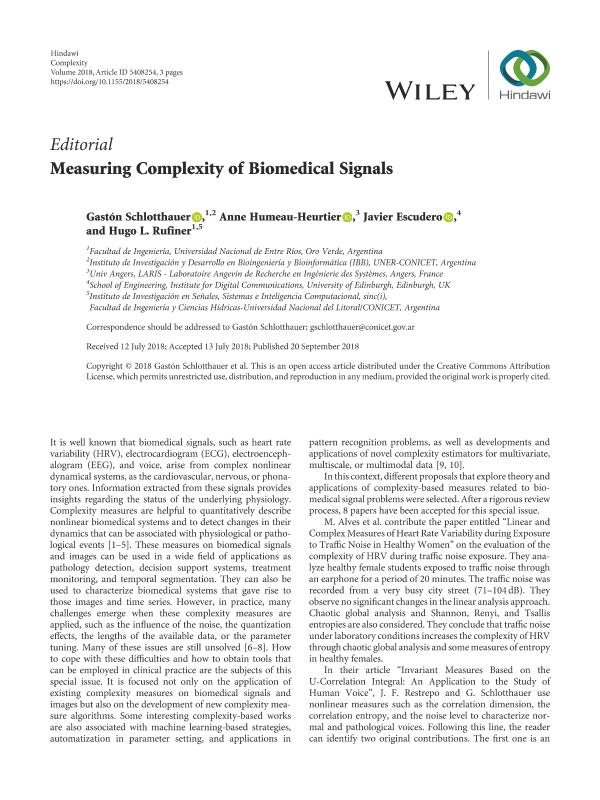Mostrar el registro sencillo del ítem
dc.contributor.author
Schlotthauer, Gaston

dc.contributor.author
Humeau-Heurtier, Anne
dc.contributor.author
Escudero, Javier
dc.contributor.author
Rufiner, Hugo Leonardo

dc.date.available
2019-10-23T19:15:30Z
dc.date.issued
2018-09
dc.identifier.citation
Schlotthauer, Gaston; Humeau-Heurtier, Anne; Escudero, Javier; Rufiner, Hugo Leonardo; Measuring complexity of biomedical signals; John Wiley & Sons Inc; Complexity; 2018; 9-2018; 1-3
dc.identifier.issn
1076-2787
dc.identifier.uri
http://hdl.handle.net/11336/87142
dc.description.abstract
It is well known that biomedical signals, such as heart rate variability (HRV), electrocardiogram (ECG), electroencephalogram (EEG), and voice, arise from complex nonlinear dynamical systems, as the cardiovascular, nervous, or phonatory ones. Information extracted from these signals provides insights regarding the status of the underlying physiology. Complexity measures are helpful to quantitatively describe nonlinear biomedical systems and to detect changes in their dynamics that can be associated with physiological or pathological events. These measures on biomedical signals and images can be used in a wide field of applications as pathology detection, decision support systems, treatment monitoring, and temporal segmentation. They can also be used to characterize biomedical systems that gave rise to those images and time series. However, in practice, many challenges emerge when these complexity measures are applied, such as the influence of the noise, the quantization effects, the lengths of the available data, or the parameter tuning. Many of these issues are still unsolved. How to cope with these difficulties and how to obtain tools that can be employed in clinical practice are the subjects of this special issue. It is focused not only on the application of existing complexity measures on biomedical signals and images but also on the development of new complexity measure algorithms. Some interesting complexity-based works are also associated with machine learning-based strategies, automatization in parameter setting, and applications in pattern recognition problems, as well as developments and applications of novel complexity estimators for multivariate, multiscale, or multimodal data. In this context, different proposals that explore theory and applications of complexity-based measures related to biomedical signal problems were selected. After a rigorous review process, 8 papers have been accepted for this special issue.
dc.format
application/pdf
dc.language.iso
eng
dc.publisher
John Wiley & Sons Inc

dc.rights
info:eu-repo/semantics/openAccess
dc.rights.uri
https://creativecommons.org/licenses/by-nc-sa/2.5/ar/
dc.subject
COMPLEXITY MEASURES
dc.subject
BIOMEDICAL SIGNALS
dc.subject
DIGITAL SIGNAL PROCESSING
dc.subject.classification
Otras Ciencias de la Computación e Información

dc.subject.classification
Ciencias de la Computación e Información

dc.subject.classification
CIENCIAS NATURALES Y EXACTAS

dc.title
Measuring complexity of biomedical signals
dc.type
info:eu-repo/semantics/article
dc.type
info:ar-repo/semantics/artículo
dc.type
info:eu-repo/semantics/publishedVersion
dc.date.updated
2019-10-22T17:42:50Z
dc.journal.volume
2018
dc.journal.pagination
1-3
dc.journal.pais
Estados Unidos

dc.journal.ciudad
New York
dc.description.fil
Fil: Schlotthauer, Gaston. Consejo Nacional de Investigaciones Científicas y Técnicas. Centro de Investigaciones y Transferencia de Entre Ríos. Universidad Nacional de Entre Ríos. Centro de Investigaciones y Transferencia de Entre Ríos; Argentina
dc.description.fil
Fil: Humeau-Heurtier, Anne. Université D'angers; Francia
dc.description.fil
Fil: Escudero, Javier. University of Edinburgh; Reino Unido
dc.description.fil
Fil: Rufiner, Hugo Leonardo. Universidad Nacional del Litoral; Argentina
dc.journal.title
Complexity

dc.relation.alternativeid
info:eu-repo/semantics/altIdentifier/url/https://www.hindawi.com/journals/complexity/2018/5408254/
dc.relation.alternativeid
info:eu-repo/semantics/altIdentifier/doi/http://dx.doi.org/10.1155/2018/5408254
Archivos asociados
